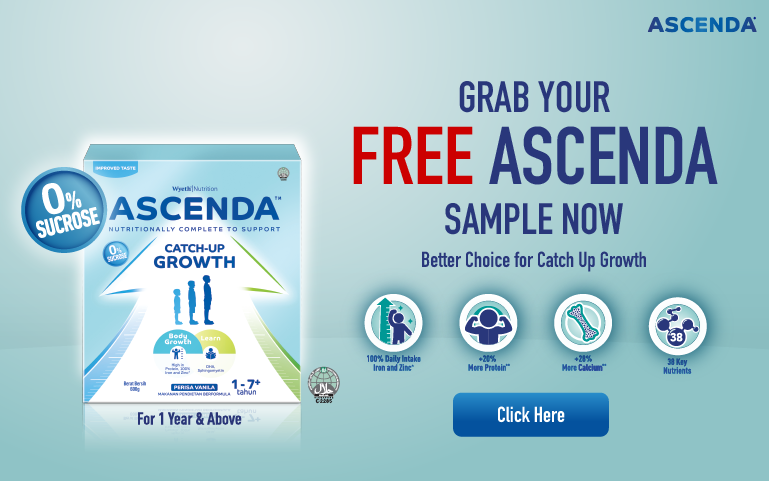
Catch-Up Growth
Malnutrition, especially undernutrition often leads to poor development and growth among children.
Malnutrition, especially undernutrition often leads to poor development and growth among children. In recent years, stunting prevalence among Malaysian children is rising as 1 out of 5 children under five are stunted and about 11 % are under nourished. Undernutrition at this tender age could pose a serious threat towards good growth and development leading to growth faltering or failure to thrive. On top of this, iron deficiency anaemia is a growing concern among the Malaysian population and the problem could be stemming from childhood. Prolonged undernourishment leads to poor cognition, immunity and it could also affect their performance in school. Therefore, it is important to ensure young children are supplied with a healthy diet with adequate macro and micronutrients to support their early growth and development to secure their health and performance in later years. One best way is to secure food environment and inclusion of healthy meals that encompass important nutrients.
Protein, a component of macronutrients supplies the body with energy and components to support vertical growth. During the early years of life, it is important to ensure that protein is abundantly available in children's diets. Stunted children's diet was found to be low in protein intake and quality. There are several windows of opportunities for children to catch up with growth due to growth spurt periods, therefore, boosting stunted children with nutrient-dense meals is an important intervention. Protein with both essential and non-essential amino acids, known also as complete protein would help to achieve proper height and weight growth.

Iron is essential during the early years as it supports brain and social-emotional development. Good iron status as per the recommended nutrient intake (RNI) is imperative to achieve the desired projected growth. Among children’s requiring catch-up growth due to growth faltering, iron has shown promising outcomes in both weight and height. Additionally, zinc is another essential nutrient to support growth, especially for catch-up growth. Being the second most rich micronutrient in the body, it is responsible for cell function and therefore a vital nutrient for immune system optimization. Research studies showed that with zinc supplementation among children with failure to thrive, a condition where height and weight are compromised, significant improvement in both height and weight was seen. One mechanism around this is zinc plays a role in energy metabolism and is a required nutrient for DNA synthesis. Similarly, folic acid and several B vitamins are also important to support these functions and growth. These nutrients interact to supply adequate energy to the body for metabolism and optimum cell function. For growing children, a diet that incorporates these nutrients is deemed complete to support their development.
Supplying children with adequate nutrition including essential micronutrients for growth allows children to maximize their potential for growth especially among children with growth faltering. Fostering good nutrition habits incorporating essential micronutrients during early years helps in ensuring consistent and required development based on age milestones. It is important to note that any further supplementation besides that from the diet should be observed by a health professional.
ASCENDA® is a Nutritionally Complete Formula scientifically designed to support the increase of height and weight along with cognitive development. Parents, let ASCENDA® be part of your routine in helping your child catch up on growth and learning. Here are some key benefits of ASCENDA®:
- 100% Daily Intake of Iron and Zinc: ASCENDA® provides essential nutrients, including iron and zinc, which are crucial for growth and development.
- +20% More Protein: Compared to a selected brand, ASCENDA® offers 20% more protein.
- +28% More Calcium: ASCENDA® contains additional calcium to support bone health and growth.
ASCENDA® is specifically formulated to support an increase in height and weight, providing the blend of nutrition needed for a child’s holistic growth. It’s a better choice for catch-up growth, and it can help children achieve positive results in as early as 3 weeks1. Remember to consult with your healthcare professional to assess your child’s growth concerns and develop an action plan if needed.
If you’re interested, you can get a free sample of ASCENDA® to try it out. Additionally, new users can redeem RM10 off their purchase1.
For more information, you can visit the official ASCENDA® website. Enjoy your parenting journey with ASCENDA®! 🌱🌟
Reference:
National Health and Morbidity Survey 2019
Prepared by:
- Assistant Professor Dr. Satvinder Kaur D/O Nachatar Singh
- Assistant Professor | Department of Food Science and Nutrition (UCSI University)
DISCLAIMER: The content is for informational purposes only and is not intended to be a substitute for professional medical advice, diagnosis, or treatment. Always seek the advice of your health professional with any questions you may have regarding a medical condition. Due to unique individual needs, the reader should consult health professional to determine the appropriateness of the information for the reader's situation.